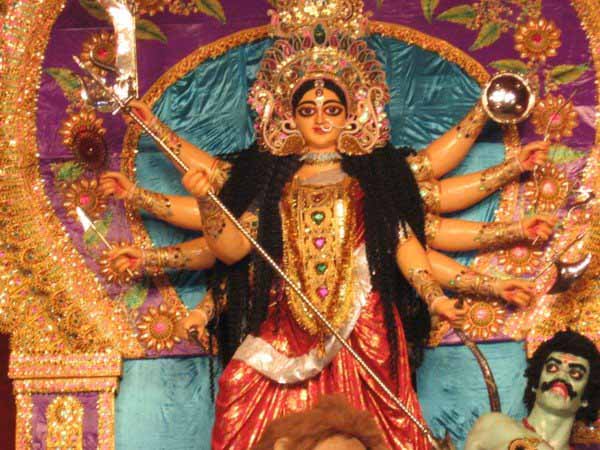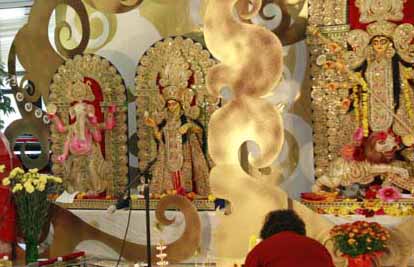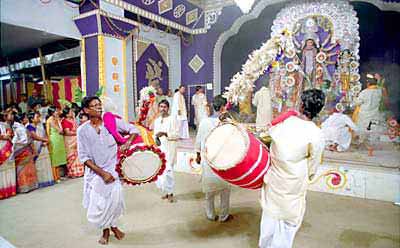 |

|
 |

|
 |
|
|
 Durga Puja is the most important festival in India. Durga Puja is more than a festival, it is a celebration of life, culture, popular customs and traditions. It is a time of reunion and rejuvenation to love, to share and to care. This festival provides a perfect platform to every Indian with rich cultural ethos and values to organize them selves under a roof. Durga Puja is an important Hindu Festival celebrated all over India with different rituals and festivities. It is celebrated in the month of September/October. The excited festivity is omnipresent during Durga Puja throughout India, specifically in East-India particularly in West Bengal. The beautiful idols of the ten headed but fierce goddess on her lion is worshipped with great enthusiasm. Legends of Durga Puja Durga is the Goddess of divine power against all evils. The story goes that Mahisasur, the Buffalo Demon, through years of praying, received blessing from Lord Brahma, that no power can kill him which means he is invincible. But once gaining this power he started ravaging the whole world and killing people. And finally he wanted to uproot the Gods too. The Gods, in dismay, combined their powers to create a beautiful maiden, and each placed his or her most potent weapon in one of her ten hands riding a lion. Her return in each year in the Bengali month of Aswin (September-October) commemorates Rama's invocation of the goddess Durga before he went into battle with Ravana. The traditional image of the Bengali Durga follows the iconographic injunctions of the Shastras. It is similar to the Durga of Aihole and of Mahabalipuram (seventh century). The tableau of Durga with her four children - Kartik, Ganesh, Saraswati and Lakshmi, representing respectively the Protector, the Initiator of the puja, Knowledge and the Provider - signifies the complete manifestation of the goddess. Another legend has it that Lord Rama went to rescue his abducted wife Sita from the grip of Ravana, the king of the demons in Lanka. Before starting for his battle with Ravana, Rama wanted the blessings of Devi Durga. Pleased with Ramaís devotion, Durga appeared before him and blessed him. The battle started on the saptami and Ravana was finally killed on the sandhikshan i.e. the crossover period between ashtami and navami and was cremated on dashami. Since the period of this worship was different from the conventional festival time of spring or basant, this puja is also known as akal-bodhan or worship (bodhan) in an unconventional time (a-kaal). Other viewed that once the mother of Durga wished to see her daughter. Durga was permitted by Lord Shiva to visit her beloved mother only for nine days in the year. The festival of Durga Puja marks this visit and ends with the Vijaya Dasami day, when Goddess Durga leaves for Her return to Mount Kailas. Rituals in Durga Puja Durga Puja is basically a festival with a series of rituals & Puja. The making of Durga idols is also governed by rituals. The elemental ritual, which is most commonly followed, is that the ingredients that are used to make the idol of goddess Durga come from the holy river Ganga. The idol of Durga is generally flanked by the idols of Lakshmi, Saraswati, Kartik and Ganesh. The image of Durga is framed at the centre, and the background behind the whole group is called the chaal-chitra. The goddess sits atop a lion, which is her vahan. The favourite tableau is of her stabbing Mahishasura, the demon. It symbolizes the victory of goddess over the demons. It is celebrated in different parts of India in different styles. But the basic aim is to propitiate Shakti, the Goddess in Her aspect as Power, to bestow upon man all wealth, auspiciousness, prosperity, knowledge, and all other potent powers. Traditional and household Durga Pujas festivities last till ten days. But the main ritual of Durga Puja spans a period of four days. Debi-Pakkha is the name given to the fortnight from the new moon till the next full moon. This is the most propitious time for performing holy rites. The ritual of drawing the eyes on the image of the goddess is called chakkhu-daan. Symbolising the process of infusing the image with the power of vision, this is done on Mahalaya, the day of the new moon. The main puja starts from Shasthi, which is the sixth day after the new moon. On Saptami, the image of the goddess is infused with life through a process called Bodhon. Early in the morning, the pran of the Devi is put inside the image after it is brought from a nearby river through the medium of a banana plant. The banana plant (Kola Bou) bathed and draped in a new yellow saree, resembles a newly wed bride. Ashtami is universally accepted as the culminating point of the four day celebrations. It was on this day that Durga had killed Mahishasura. The ritual of Sandhipuja marks Sandhikkhan, the juncture between Ashtami and Nabami. The main attraction of Nabami is the Maha-Arati held in the evening. On Dashami, the image is immersed in a river. Bijoya is a special ritual whereby peace and good relations are reaffirmed. Families exchange sweets and people embrace each other, vowing brotherhood. Bijoya continues till the next new moon, when Kali Puja is held. Celebration of Durga Puja Durga Puja has transcended
geographical boundaries and reached every corner across the globe. The
four-day fair - has become an indispensable part of every one's life in
India.
It is one of the biggest festivals in Bengal. Durga Puja is celebrated on a mass scale with puja pandals dotting nearly every corner of West Bengal. Community pujas in Bengal are organised in every locality. On the final day the idols are taken in elaborate processions to be immersed in the river or the pond. Such is the charm and seduction of the occasion that several big community pujas in the city are being sponsored by multi-national companies and commercial firms. The inauguration starts on Mahashasthi. The main puja is for three days - Mahasaptami, Mahaastami, & Mahanavami. Three days of Mantras and Shlokas and Arati and offerings - needs an expert priest to do this kind of Puja. Because of these facts, the number of Pujas held in the family has reduced and Durga Puja has mostly emerged as a community festival. The city of Calcutta takes a different look during these three days, especially at night. Millions of people come to the city and line up before the pandals. The streets are lighted and the electricians display all different kind of light shows. The restaurants are packed and numerous temporary food stalls are opened though out the city. Schools, colleges, offices remain closed during these four days. Bengalis in other cities in India visit their relatives in West Bengal. After the three days of Puja, in Dashami, in the last day, a tearful farewell is offered to the Goddess. The idols are carried in processions around the locality and finally are immersed in a nearby river or lake. Bengalis all over the world tries to celebrate this great event of their culture. In West- Bengalís neighbour state Orissa the festivals of Durga Puja celebrate in a similar manner. Especially in the city of Cuttack a large number of idols of Durga and Mahadev are worshipped in profusely decorated pandals. Life comes to a stand-still in the city as crowds pour over the Puja Mandaps to enjoy the festivities. On the day succeeding 'Vijaya Dasami', the last day of Dussera, the images are taken in a spectacular procession for immersion in the river Kathajodi.  History of Durga Puja in Bengal dates back to the Mughal era. History said that the first Puja was organised by Raja Kangshanarayan of Teherpur, Nadia and then Raja Jagatnarayan of Bhaduria followed soon after. Other Hindu kings too came forward and the puja spread far and wide to Gour, RajMahal, Murshibad and Krishnagar. By mid of 18th Century, this festival had become the occasion for the nouveaux riches Babus of Kolkata to flaunt their wealth. They invited Europeans in every evening in their feast to grace their occasion. The British too Participated enthusiastically and had Prassad and did Pranam, often lying Prostrate on the ground. Some believe that the Puja of Saborno Chowdhury is the oldest puja in the city started at 1610 near Behala sakher Bazaar area. Second oldest Durgapuja is the Puja of Govindaram Mitra of Kumartuli at the ealier 1800. Next renowned oldest Durgapuja is the Puja of Sovbazaar Raj Bar.
 |
| Privacy Policy for LiveIndia.Com |